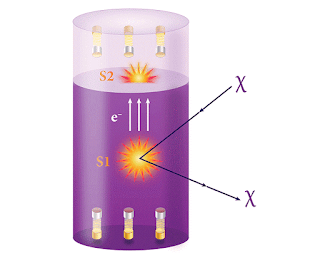Topics: Astronomy, Astrophysics, Cosmology, Dark Matter
Over 80 years ago astronomers and astrophysicists began to inventory the amount of matter in the Universe. In doing so, they stumbled into an incredible discovery: the motion of stars within galaxies, and of galaxies within galaxy clusters, could not be explained by the gravitational tug of visible matter alone [1]. So to rectify the situation, they suggested the presence of a large amount of invisible, or “dark,” matter. We now know that dark matter makes up 84% of the matter in the Universe [2], but its composition—the type of particle or particles it’s made from—remains a mystery. Researchers have pursued a myriad of theoretical candidates, but none of these “suspects” have been apprehended. The lack of detection has helped better define the parameters, such as masses and interaction strengths, that could characterize the particles. For the most compelling dark matter candidate, WIMPs, the viable parameter space has recently become smaller with the announcement in September 2016 by the PandaX-II Collaboration [3] and now by the Large Underground Xenon (LUX) Collaboration [4] that a search for the particles has come up empty.
Since physicists don’t know what dark matter is, they need a diverse portfolio of instruments and approaches to detect it. One technique is to try to make dark matter in an accelerator, such as the Large Hadron Collider at CERN, and then to look for its decay products with a particle detector. A second technique is to use instruments such as the Fermi Gamma-ray Space Telescope to observe dark matter interactions in and beyond our Galaxy. This approach is called “indirect detection” because what the telescope actually observes is the particles produced by a collision between dark matter particles. In the same way that forensic scientists rely on physical evidence to reverse-engineer a crime with no witnesses, scientists use the aftermath of these collisions to reconstruct the identities of the initial dark matter particles.
The third technique, and the one used in both the LUX and PandaX-II experiments, is known as “direct detection.” Here, a detector is constructed on Earth with a massive target to increase the odds of an interaction with the dark matter that exists in our Galaxy. In the case of LUX and PandaX-II, the dark matter particles leave behind traces of light that can be detected with sophisticated sensors. This is akin to having placed cameras at the scene of a crime, capturing the culprit in the act.
The heart of both LUX, located in South Dakota in the US, and PandaX-II, situated in Sichuan, China, is a time-projection chamber. This consists of a large tank of ultrapure liquid xenon—250 kg at LUX and 500 kg at PandaX-II—topped with xenon gas (Fig. 1). A particle (dark matter or ordinary matter) that enters the chamber and interacts with a xenon atom in the liquid generates photons (by scintillation) and electrons (by ionization). The photons produce a signal, S1, which is read by photomultiplier tubes located at the top and bottom of the tank. The electrons are instead coaxed into the gaseous portion of the detector by an electric field where they induce a second round of scintillation and a signal S2. The pattern of S1 and S2 signals is different when the xenon interacts with a dark matter particle than with an ordinary particle, which is what allows scientists to distinguish between two such events. To reduce the background signal from ordinary particles, both LUX and PandaX-II are buried underground to provide protection from cosmic rays. In addition, the use of ultrapure materials in the construction of the experiment cuts the background contributed by radioactive emissions.
APS Viewpoint: Dark Matter Still at Large
Jodi A. Cooley, Department of Physics, Southern Methodist University, 3215 Daniel Ave., Dallas, TX 75205, USA
January 11, 2017• Physics 10, 3

Comments